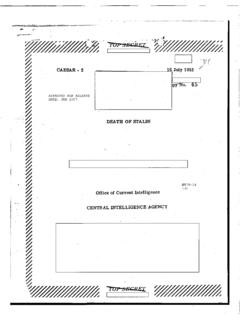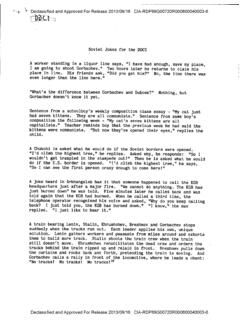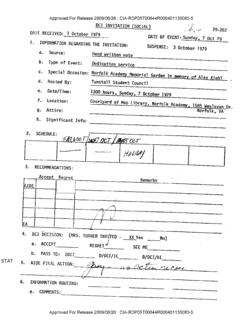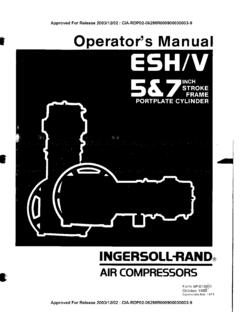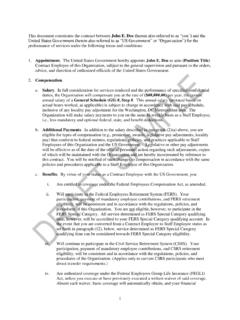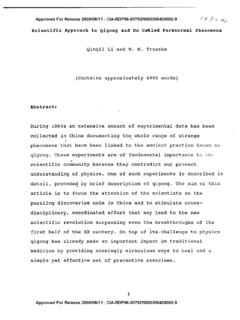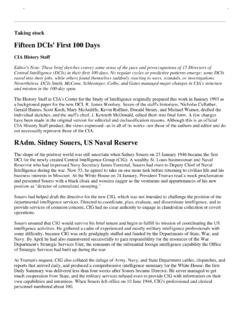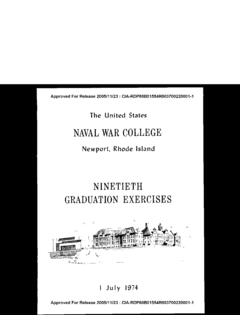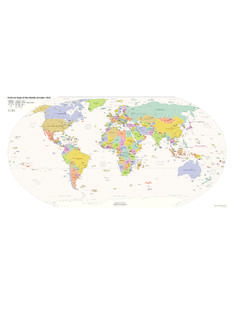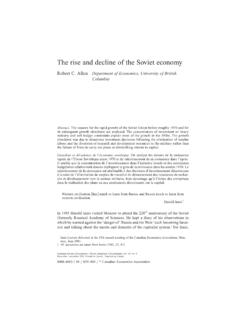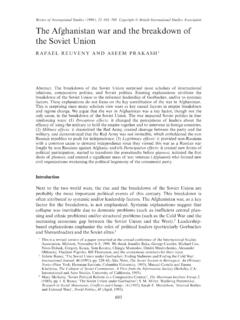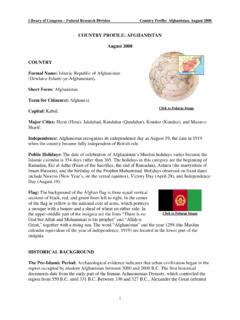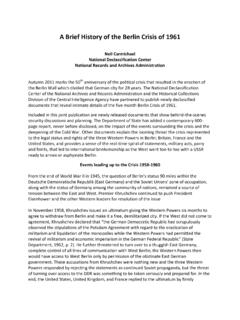Transcription of Soviet Deception in the Cuban Missile Crisis
1 Studies in Intelligence Vol. 46 No. 1 (2002). Soviet Deception in the Cuban Missile Crisis Learning from the Past James H. Hansen Moscow's surreptitious dispatch of nuclear-capable SS-4 and SS-5. surface-to-surface missiles to Cuba in 1962 upset the strategic balance in an alarming The resulting showdown which the Russians call the "Caribbean Crisis " and the Cubans call the "October Crisis " brought the world to the brink of nuclear war. From its inception, the Soviet Missile operation entailed elaborate denial and Deception (D&D) efforts. The craft of denying the United States information on the deployment of the missiles and deceiving US policymakers about the Soviet Union's intent was the foundation of Nikita Khrushchev's audacious Cuban venture.
2 Piecing together the Deception activities from declassi ed US, Russian, and Cuban accounts yields insights that can help us anticipate and overcome the D&D efforts of a growing number of foreign adversaries today. Range of Soviet SS-4 medium-range ballistic missiles and SS-5 intermediate-range ballistic missiles, if launched from Cuba. Maskirovka Moscow has always had a air for D&D, known in Russian as maskirovka. Its central tenet is to prevent an adversary from discovering Russian intentions by deceiving him about the nature, scope, and timing of an operation. Maskirovka covers a broad range of concepts, from Deception at the strategic planning level to camou age at the troop Russian military texts indicate that maskirovka is treated as an operational art to be polished by professors of military science and of cers who specialize in this area.
3 DIA analysis preceding the Missile Crisis noted that the Soviet Army had probably employed large-scale battle eld Deception "more frequently and with more consistent success than any other army."3 The Soviets practiced extensive maskirovka before their move into Czechoslovakia in 1968. Moscow also trained foreign forces to apply Deception , including North Vietnamese units before the Tet offensive in 1968 and Egyptian forces before crossing the Suez Canal in 1973. Close-hold Planning Gen. Anatoli Gribkov then a senior member of the Soviet General Staff . provides revealing insights into the early planning of the operation. He says that, after Nikita Khrushchev decided to emplace the missiles in Cuba in the spring of 1962, the General Staff detailed only ve of cers four generals and a colonel to serve as the center of the military planning apparatus.
4 Col. Gen. Semyon Ivanov, chief of the General Staff's Chief Operations Directorate, was in overall During that summer, the circle of collaborators and contacts expanded to include members of each of the relevant service branches, but secrecy and need-to-know prevailed. The most senior of cers brought into the plan were at least told that Cuba was involved in the operation, but only a few were informed of the exact nature of the The top civilian and military of cials conceptualizing the operation did not see eye-to-eye about the likelihood of pulling off a successful Deception . At the very center of those making the decisions stood First Deputy Prime Minister Anastas Mikoyan, Presidium member Frol Kozlov, Defense Minister Marshal Rodion Malinovsky, and Marshal Sergei Biryuzov, commander of the Strategic Rocket Alternate Presidium member Sharaf Rashidov was brought in as well, possibly for the cover that he later provided for traveling Biryuzov and his experts believed that the deployment could be made expeditiously and secretly, without the US.
5 Discovering the missiles. Mikoyan was surprised at this judgment and believed the marshal to be a Rashidov was con dent that the missiles could be hidden, claiming that they could be placed so as to blend in with the palm trees. Gribkov held that only somebody inexperienced in military matters could reach such a conclusion, given the extensive preparations needed for each Missile site. Throughout the early planning stage, no secretaries were used to prepare nal typed texts. A colonel with good penmanship wrote the proposal that the Defense Council adopted. It grew into a full- edged plan, still handwritten, which was approved by Malinovsky on 4 July and Khrushchev on 7 From May through October, for reasons of security, no communications about the proposed, planned, and actual Soviet deployments in Cuba were sent, even by coded messages.
6 Everything was hand-carried by members of the small coterie of senior of cials who were directly Developing A Cover Story The General Staff's code name for the operation ANADYR was designed to mislead Soviets as well as foreigners about the destination of the equipment. Anadyr is the name of a river owing into the Bering Sea, the capital of the Chukotsky Autonomous District, and a bomber base in that desolate region. Operation ANADYR was designed to sugest to lower-level Soviet commanders and Western spies that the action was a strategic exercise in the far north of the USSR. Promoting the illusion, the troops that were called up for the Cuban expedition were told only that they were going to a cold region. Those needing more precise instructions, such as Missile engineers, were informed that they would be taking ICBMs to a site on Novaya Zemlya, a large island in the Arctic where nuclear weapons had long been To strengthen the concealment, many units were out tted with skis, felt boots, eece-lined parkas, and other winter Moreover, perhaps to further backstop the cover plan, Moscow tapped four ground forces regiments from the Leningrad Military District in the north for dispatch to Cuba.
7 The Deception was so thorough that it fooled even senior Soviet of cers sent to Cuba. One general there asked Gribkov why winter equipment and clothing had been provided. The general admonished him to "think like an adult," and explained, "It's called ANADYR. for a reason. We could have given away the game if we had put any tropical clothing in your kits."13. Getting the Cubans On Board Secrecy surrounded the rst Soviet delegation that went to propose the audacious plan to Fidel Castro and other Cuban leaders. The of cials arrived in Havana with little fanfare on 29 May, amidst a delegation of agricultural experts headed by Rashidov. The group included Col. Gen. Ivanov and several Missile construction specialists and other military experts, whose job it was to determine whether the missiles could be deployed in Ambassador Aleksandr Alekseev took Cuban Defense Minister Raul Castro aside to explain that "Engineer Petrov" in the group actually was Marshal Biryuzov, and that he needed to meet with el lider maximo without delay.
8 Only three hours later "Engineer Petrov" was shown into Fidel Castro's of The Cuban leadership unanimously and enthusiastically gave its approval in Soviet maritime policy began to shift in accordance with these rst trips. In June and July, the USSR began to charter Western ships to carry general cargo from the Soviet Union to Cuba, reserving its own freighters for carrying military During 2-17 July, a Cuban delegation led by Raul Castro traveled to Moscow to discuss Soviet military shipments, including nuclear missiles. Khrushchev met with the Defense Minister on 3 and 8 July. Raul Castro initialed a draft treaty with the Soviet Defense Minister that governed the deployment of Soviet forces to Cuba. This pact was not to be publicly revealed until a visit that Khrushchev planned to make to Cuba in The Russians began to dispatch of cers and specialists covertly to Cuba by air.
9 On 10 July, Gen. Issa Pliyev, traveling under the name "Pavlov,". arrived in Cuba to command the Soviet Two days later, 67. specialists touched down. They journeyed as "machine operators,". "irrigation specialists," and "agricultural specialists." Their covers, however, could not have withstood probing they had been assigned to occupations about which they knew nothing. They were urged to consult the few genuine specialists traveling with them to gain some rudimentary knowledge of their ostensible On 17 July, Havana announced that Cuba and the USSR had signed an agreement establishing a regular Moscow-Havana civil air route. US intelligence analysis at the time speculated that the new Tu-114 ights were bringing Soviet military of cers and sensitive electronic and signal-monitoring equipment to Then-Minister for Industry Ernesto "Che" Guevara and the head of the Cuban militia led another delegation to Moscow during 27 August-2.
10 September. The purpose was to introduce Fidel Castro's revisions into the draft treaty. The Cubans proposed that the deployment be made public in order to head off any American overreaction; Khrushchev, however, successfully argued for continued secrecy. Keeping The Secret At Home In the Soviet Union, the men and equipment destined for Cuba were assembled, loaded, and moved by rail at night under reinforced guard. The train routes and nal destinations were kept secret. Mail and telegrams along the way were strictly To mask the immensity of the overall effort, the shipments to Cuba left from eight ports four in the north (Kronstadt, Liepaya, Baltiysk, and Murmansk) and four on the Black Sea (Sevastopol, Feodosiya, Nikolayev, and Poti).
